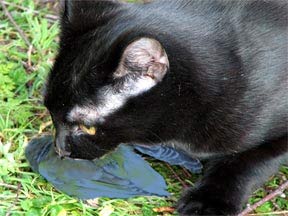 Killer Housecats
Killer Housecats
Moving along... another issue that's been in the news lately is the possibility that housecats have been decimating songbirds. One post I read suggested that a pet cat who is let outside can kill 20 to 50 birds per year.
Of course, cats might only be getting those birds that would have been caught by hawks or foxes, or that would have succumbed to cold or heat or hunger. And not every cat is a lean mean killing machine.
So, how could you design a study to test whether housecats are really having an impact? You could approach it like the fish ponds, and look for towns with cats and towns without cats. There's a problem, though: at 90 million strong, cats are the favorite American pet. You probably won't find many towns without them.
Instead, you could sample the populations in a number of towns, and record both how many cats and how many birds there are, like this:
|
Note on the data: I made up these numbers, but I based them on real information: an estimate of US bird population of about 6 billion birds (in the summer), and the year-round pet cat population of about 80 million. I assumed cats were concentrated in residential areas, where there would be 1 cat for every 3 people. I assumed that birds would be evenly spread throughout the country. Finally, each sample area was 1 square mile, with a density of about 6000 people (typical of suburban areas). |
Now we just need to figure out how to analyze this data. Here's a way that does NOT help:
- average # of cats: (2000+3000+4000...)/10 = 2140 cats
- average # of birds: (1600+600+200...)/10 = 1640 birds
Why not? We're trying to show that the number of birds DEPENDS on the number of cats. Just taking the average for each is not going to show that. Its an example of MATH RUN AMOK -- you CAN do this, but it doesn't do any good.
Copyright University of Maryland, 2007
You may link to this site for educational purposes.
Please do not copy without permission
requests/questions/feedback email: mathbench@umd.edu